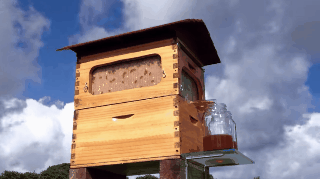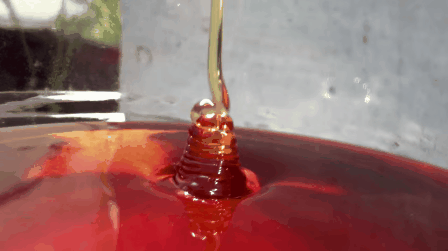3,200,000 dollars for honey from a hive “tap”
Published 24 February 2015 by Quentin Chevrier
3.2 million dollars for hives from which honey flows “all by itself”. The Australian prototype has exploded the counter of its crowdfunding campaign and rallied apprentice beekeepers. Makery wanted to know more…
Endangered, ubiquitous in the media, the object of numerous lab projects (open source hives, hive sensors…) and kept right in the city, bees are certainly trending. Supplanting hives on rooftops in Lyon and Paris, the Flow Hive project is blowing up the counter of its crowdfunding campaign. Almost 4,600 % of the initial $70,000 goal has been raised since February 22, amounting to about 3.2 million dollars !
Honey from the tap

3.2 million dollars for a system that fills a honey pot from a tap plugged right into the hive. Instead of sedating the bees with smoke, removing the frames, placing them on a centrifuge, extracting the honey, replacing the frames and filtering the honey, Flow Hive predicts a radiant beekeeping future, “the biggest innovation in beekeeping since 1852” (year in which the hive was patented).
The Anderson family modestly promises pure honey pots using a simple mechanism—by opening a tap, the honeycomb cells shift to let the honey they contain flow out of the hive and into a tube that pours into a container (the system is patented). No more need to handle frames covered with bees.

Skeptical beekeepers
Bruno Petit, beekeeper at Miel Paris, raises several questions regarding this project.
“It’s a gadget for amateur beekeepers. No professional would be interested.” Bruno Petit, beekeeper
“The system doesn’t adapt to just any brand of hive,” Petit explains. “For example, Dadant, the most common brand in France, is not compatible.” Not to mention the fact that not all types of honey can be extracted in this way. “Only honey that is very liquid and cultivated in warm weather will flow properly,” he adds. “The spring harvest is a honey that crystallizes very quickly. If it’s a little cool, the honey will crystallize in the tube and block the system. This can’t work with heather honey, for example, or other very viscous types of honey.”

Petit is not the only skeptic. On one of the world’s major beekeeping forums, Beesource.com, opinions converge : from a professional standpoint, the system is uninteresting. “The harvest is the fastest and least technical part of the job,” Petit says. “The harvests and honey extraction take up about 3 % of the season’s total work time.”
Flow Hive uses the force of gravity to make the honey drip out of the honeycomb, while professionals use centrifuges that rotate several hundred times a minute. Even with this method, “It’s sometimes hard to extract the honey” Petit says. “In spring 2014, for example, the honey was so crystallized that we lost 15 % of the harvest. Using only the force of gravity, we would have lost even more.”
For (rich) amateurs…
Even if it is aimed exclusively at amateurs, the project is no less “horribly expensive”, according to a member of the Beesource.com forum. The hive costs a total of 600 dollars, when experienced amateurs confirm that they can set up a hive “for about 140 dollars”.
Flow Hive deceives those who are already dreaming of enormous farms of hives all connected by long tubes to a no less enormous container. But the project delights many aspiring “backyarder” beekeepers. In any case, more than 7,700 funders have pre-ordered anywhere from a box to a few frames to the complete Full Flow Hive, seduced by the promise of an automatic dispenser of ready-to-eat honey (bees not included).
Some, however, are beginning to discover the reality of beekeeping through the Facebook group Flow Hive Beekeeping. Indeed, one day or another you’ll have to open up the hive to clean it before winter, treat the bees against pesticides, diseases and other parasites that ravage these buzzing insects worldwide.
